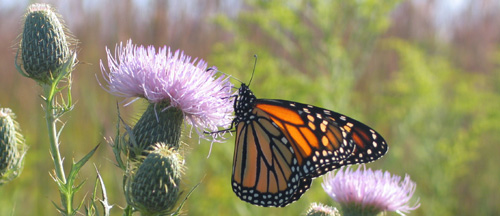
Monarch Butterfly Migration
Over Central Iowa in Fall 2005
By Robert D. Woodward
During the summer of 2005, field observations at Neal Smith National Wildlife Refuge showed strong numbers of "resident " monarchs in June, July and August. As the days moved down to the end of August, a shift in the monarch activity indicated the residents were being joined by early monarch migrants from the north. A report from Minnesota on August 29 indicated the monarch migratory activity had begun in that state.
August 27 and 28--Visits to Neal Smith National Wildlife Refuge turned up 20 monarchs Saturday and 16 monarchs Sunday. On each day, several of the monarchs were seen flying into the refuge from the north, and they seemed to be part of the early migration.
August 30--Early monarch migration activity was noted today at Neal Smith National Wildlife Refuge. During an hour and one-half visit, 44 monarchs were observed on the prairie. Most of them were nectaring on thistles even though other monarch favorites such as goldenrod and tickseed sunflowers are now blooming, too. It's interesting to note which wildflowers seem to be the favorites during different days in the fall migration season. In other years, goldenrod and tickseed sunflowers have proven to be popular at times with the migrating butterflies.

A migrating monarch butterfly makes a morning visit to a thistle.
August 31--The migrating monarch butterflies were highly active again at Neal Smith National Wildlife Refuge, especially in a stand of tickseed sunflowers. During an observation visit of a bit more than an hour in mid-afternoon, 56 monarchs were counted. Many of them were found flying in and out of the tickseed sunflowers where they were nectaring. From a distance, only an occasional butterfly could be spotted floating into the mass of yellow flowers, but a walk into the center of the stand of plants brought one of those magical moments where the monarchs showed their colors by flying about in all directions. This was the first time this autumn when the monarchs were seen primarily on wildflowers other than thistles.
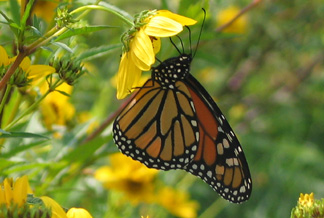
On August 31, a monarch stops on a tickseed sunflower.
September 1--Monarchs were observed flying into the north part of Neal Smith National Wildlife Refuge as the fall migration continued to expand. Seventy monarchs were counted during an hour and one-half visit to the refuge. Monarchs were nectaring on thistles and tickseed sunflowers, and others were observed flying and floating across the prairie's big bluestem grasses.
September 2--On this day, migrating monarchs could be found along a savanna trail in Neal Smith National Wildlife Refuge. The trail sits on the edge of a wooded area that opens out onto the prairie filled with wildflowers and grasses. Monarchs were not readily apparent in the northern part of the refuge during a morning visit, but a walk along the savanna trail showed where the butterflies could be found. Several were flying out of the trees and onto the prairie for nectaring. Others were feeding on thistles adjoining the trail. In all, 83 monarchs were counted in an hour and one-half.

A monarch nectars where the prairie meets the woodland.
September 3--The number of migrating monarchs continued to increase at Neal Smith National Wildlife Refuge. Many more could be seen flying into the refuge from the north. The monarchs also were actively nectaring in a stand of tickseed sunflowers and along a savanna trail to the south. In two hours of observing, 246 monarchs were counted. The prairie also is alive with the activity of varieties of swallowtail butterflies, migrating dragonflies, and the ever-present sounds of goldfinches enjoying their harvest from the thistle tops. For two successsive days, giant swallowtails have been noted along the savanna trail, and they provide another special sight on the prairie scene.
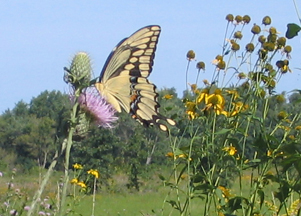
A beautiful giant swallowtail brightens the September day.
September 4--Strong winds from the east greatly limited butterfly activity at Neal Smith National Wildlife Refuge in the late afternoon. Unlike the previous day when the count of migrating monarchs was high, only seven monarchs were observed during a one-half hour visit.
September 6, 2005--Thirty-nine monarchs were noted during a one-hour visit to Neal Smith National Wildlife Refuge. Monarchs were flying into the refuge from the north, but a search in other parts of the refuge turned up only a few others.
September 7--Monarchs have been increasing in our butterflly garden in Altoona during recent days, and today they could be seen regularly criss-crossing the garden and nectaring on the flowers. Several were seen stopping off in the apple trees, and at dusk, they were flying here and there in the back garden. An estimated 15 to 20 monarchs were roosting in apple and chokecherry trees.
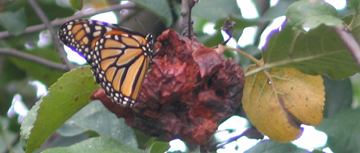
A monarch rests on a dried-out Northern Spy apple in the butterfly garden.
September 8--This was a special day for monarch watching. The activity in our butterfly garden late yesterday suggested the migratory activity likely would pick up elsewhere in central Iowa, too. During a three-hour visit this morning to Neal Smith National Wildlife Refuge, 615 monarchs were counted--the most during a visit this autumn. The monarchs were nectaring on varieties of sunflowers and thistles, and they were found in several areas of the refuge. More than a hundred were counted near a savanna trail that has woodlands on one side and the open prairie on the other. The monarchs were flying out of the woods onto the prairie and were nectaring on tickseed sunflowers. Another stand of tickseeds at the refuge also has become a favorite stopping point for monarchs, and a number were counted there. Another 150 were flying into a stand of tall sunflowers and nectaring there, creating scenes of 5 to 10 monarchs billowing up from the plants into the sky at a single time. Near midday, the skies were darkening to the northwest, and soon a powerful wind and rainstorm burst across the prairie, showing the natural threats that monarchs face during their migration south. The winds in parts of central Iowa hit more than 80 miles an hour, and 40 to 50 mph winds were common. The rainfall was torrential with 1 to 2 inches common in a short time. By mid-afternoon, however, the sun came out again, and the air was cool. Monarchs were on the move again, and in our butterfly garden in Altoona, some 30 monarchs were observed flying in and out. They stopped on apple trees, a mountain ash, and walnut trees to dry out their wings and to rest for the day.
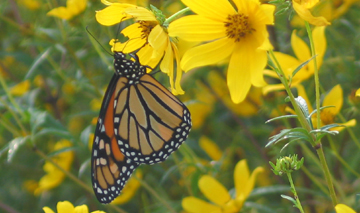
Tickseeds provide a favorite for monarchs and their nectaring.
September 9--The morning was sunny, hazy, and with a temperature in the 70s. A light breeze was blowing across the prairie at Neal Smith National Wildlife Refuge, and the monarch butterflies were on the move again. During a visit of one and one-half hours, 186 monarchs were counted at the refuge. They were highly active, flying in and out of the wildflowers and across the big bluestem grasses.
September 10-11--The days were quite warm, and the wind was strong both days. In our butterfly garden in Altoona, 20 to 30 monarchs were observed each day, nectaring on the wildflowers and resting on the leaves of apple and walnut trees, chokecherries, oaks, and even a hazelnut bush. The presence of the monarchs in the butterfly garden was much stronger than it had been in recent years of the fall migration.
September 12--An afternoon visit to Neal Smith National Wildlife Refuge confirmed what had been likely. A strong wind from the south southwest appeared to be limiting monarch movement across the refuge. The wind was 25-35 miles an hour, and the few monarchs observed appeared to be struggling to move across the prairie. Ten monarchs were counted during a half-hour visit. Back home in our butterfly garden, monarchs were continuing to visit, finding places out of the wind to nectar and to rest.
September 13--The first monarch of the morning was noted at 8:45 a.m. flying into our butterfly garden, and within an hour, 18 monarchs were counted in various parts of the garden. A visit to Neal Smith National Wildlife Refuge later in the morning turned up 30 monarchs during an hour of observation.
September 14--The day was sunny with a few clouds and a temperature in the 60s. Ninety-one monarchs were counted at Neal Smith National Wildlife Refuge in an hour and 15 minutes. Monarch activity also continued in our butterfly garden.
September 15--Monarch activity continued in our butterfly garden and at Neal Smith National Wildlife Refuge. The morning was cooler--in the 50s--and a visit to the refuge starting at 8:55 a.m. found only seven monarchs during the first hour. But in a second hour, another 60 monarchs were counted--especially where they were nectaring in tall sunflowers in the north part of the refuge.
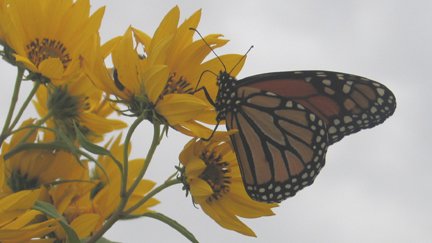
Monarch nectars on sunflowers at Neal Smith National Wildlife Refuge.
September 16--Monarch butterflies continued to fly in and out of our butterfly garden in Altoona, and they were seen flying across the roadways in the area.
September 17--The day was sunny and cool, and it seemed like a perfect time for migrating monarchs. But during a morning visit to Neal Smith National Wildlife Refuge, no major movement into the refuge was noted in the northern part. Around 9:30 a.m., the monarchs started moving in several areas of the refuge, and 44 were counted during a visit of a bit more than one hour. In our butterfly garden in the afternoon, constant monarch activity was observed once again.
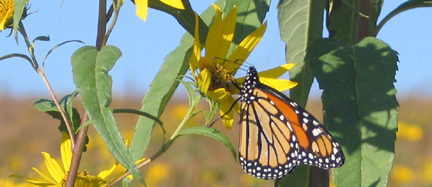
Another monarch traveler stops along the way on September 17.
September 18--This Sunday was much like the day before in terms of monarch activity with 45 monarchs observed in more than an hour at the Neal Smith National Wildlife Refuge. Monarchs continued to rest and to nectar in our butterfly garden.
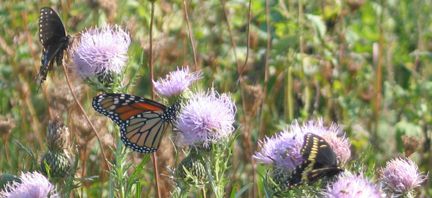
Two swallowtails joined a monarch in nectaring on thistles in the Sunday sun.
September 20--Monarch migration activity was continuing at Neal Smith National Wildlife Refuge. Eighty-two monarchs were observed during a visit of one hour and one-half. They were nectaring on sunflowers, thistles, and clover. The day was sunny with a temperature in the 70s in the morning.
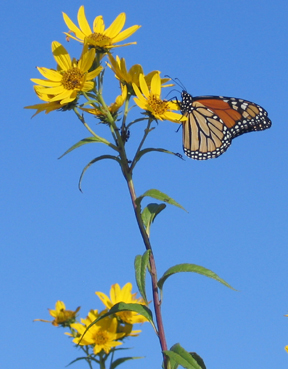
A monarch enjoys a beautiful day on the prairie.
September 21--The purple asters, a favorite of migrating monarchs, are blooming now at Neal Smith National Wlldlife Refuge and in our butterfly garden in Altoona. As the days go by, more monarchs can be seen nectaring on the asters. Today was one of those days in our front garden, when monarchs could be seen circling the asters and stopping for the nectar.
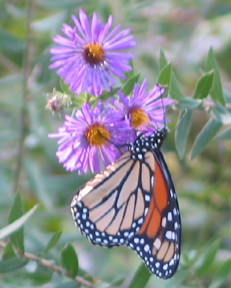
A monarch finds a favorite flower.
September 22--A cold front passed through central Iowa Thursday, bringing with it strong winds from the northwest that posed difficulties for any migrating monarchs . At Neal Smith National Wildlife Refuge, 56 monarchs were counted during a two-hour visit. Shortly after 9 a.m., a magical time occurred when, for 15 to 20 minutes, monarchs could be seen moving quickly from the open prairie into the woods along the refuge's savanna trail. Thirty-five to 40 of the monarchs came racing and floating on the wind one at a time into the wooded area of oaks and walnut trees. This "show" then ended as quickly as it had begun as the landscape was ever-changing in the strong winds of 15 to 20 miles an hour with even stronger gusts. The sky was filled with fast-moving cumulus clouds, but the monarchs had disappeared. Back home in our butterfly garden, no monarchs were seen--the first time in several weeks this had happened.
September 23--In the wake of the passage of a cold front Thursday, the possibility existed more monarch butterflies might be coming down from the north on their migratory flight. But during a visit of one hour and 20 minutes to Neal Smith National Wildlife Refuge, only four monarchs were observed in the late afternoon. Two monarchs were seen later in our butterfly garden in Altoona.
September 24--Rainfall over night left the morning damp and cloudy, and no monarchs were observed during the day.
September 25--The morning was a bit foggy and damp with the possibility of rain by midday. It appears most of the migrating monarchs have passed by Neal Smith National Wildlife Refuge. Four monarchs were observed during a half hour. Then the skies to the north darkened considerably, the wind changed to the north northwest, and the temperature dropped. The rains came later in the morning and in the afternoon.
September 27--At midday, four monarchs were observed at Neal Smith National Wildlife Refuge, and the migration clearly seemed to be at an end in central Iowa. No monarchs were observed in our butterfly garden in Altoona, Iowa.
Do what you can to help in saving the monarchs.